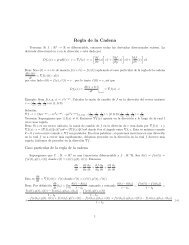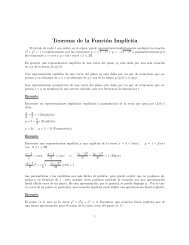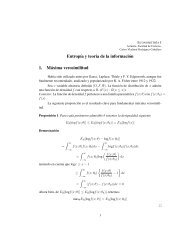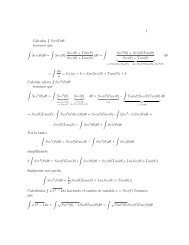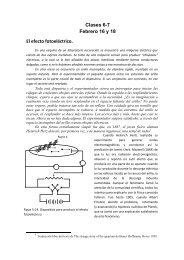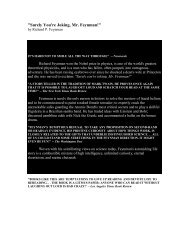Parametrizando la epicicloide - unam
Parametrizando la epicicloide - unam
Parametrizando la epicicloide - unam
You also want an ePaper? Increase the reach of your titles
YUMPU automatically turns print PDFs into web optimized ePapers that Google loves.
Ejemplo.- Halle una función vectorial que represente <strong>la</strong> curva de <strong>la</strong> intersección del cilindro<br />
x 2 + y 2 = 1 y el p<strong>la</strong>no y + z = 2.<br />
La figura muestra <strong>la</strong> forma en que se cruzan, el p<strong>la</strong>no y el cilindro, así mismo <strong>la</strong> figura ilustra<br />
<strong>la</strong> curva de intersección.<br />
La proyección C sobre el p<strong>la</strong>no xy es el circulo x 2 + y 2 = 0, z = 0, x = cos t, y = sin t,<br />
Sea<br />
0 ≤ t ≤ 2π, con base en <strong>la</strong> ecuacion del p<strong>la</strong>no, tenemos que z = 2 − y = 2 − sin t<br />
∴ x = cos t, y = sin t, z = 2 − sin t, 0 ≤ t ≤ 2π<br />
∴ <strong>la</strong> ecuación vectorial correspondiente es<br />
entonces el Dom(f) = n<br />
i=1 xi(t)<br />
r(t) = cos ti + sin tj + (2 − sin t)k 0 ≤ t ≤ 2π.<br />
f(t) = (x1(t)), x2(t)), ..., xn(t)) ∈ R n<br />
Ejemplo.-Halle el dominio de <strong>la</strong> función vectorial f(t) = (t 2 , √ t − 1, √ 5 − t)<br />
Sol. tenemos que<br />
Si x1(t) = t 2<br />
entonces Dom(x1(t)) = R<br />
Si x2(t) = √ t − 1 entonces Dom(x2(t)) = {t ∈ R|t ≥ 1}<br />
Si x3(t) = √ 5 − t entonces Dom(x3(t)) = {t ∈ R|5 ≥ t}<br />
4




